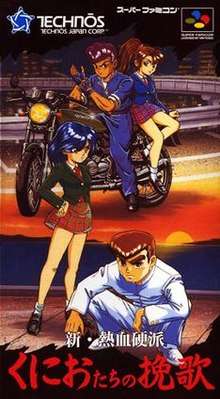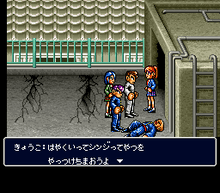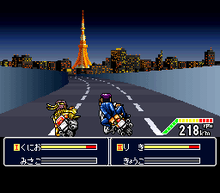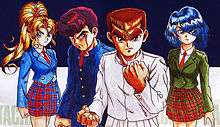Shin Nekketsu Kōha: Kunio-tachi no Banka
| Shin Nekketsu Kōha: Kunio-tachi no Banka | |
|---|---|
 Cover art | |
| Developer(s) | Almanic Corp. |
| Publisher(s) | Technos Japan Corp. |
| Designer(s) | Yoshihisa Kishimoto |
| Composer(s) | Kazunaka Yamane |
| Series | Kunio-kun |
| Platform(s) | Super Famicom |
| Release |
|
| Genre(s) | Beat 'em up |
| Mode(s) |
Single-player Two-player |
Shin Nekketsu Kōha: Kunio-tachi no Banka (新・熱血硬派 くにおたちの挽歌 The New Hot-Blooded Tough Guy: The Eulogy of Kunio and Co.) is a belt-scrolling action game released by Technos Japan Corp. exclusively in Japan for the Super Famicom in 1994. It was the fourth game in the Kunio-kun series released for the Super Famicom and was developed by Almanic. It is a prequel to Downtown Nekketsu Monogatari (better known as River City Ransom).
Plot
Kunio and Riki are convicted of a hit and run and the pair are imprisoned in a juvenile correction facility. However, the two claim to be innocent. The next morning, the duo are visited by Kunio's friend Hiroshi, who informs them of a series of suspicious events transpiring in and around Nekketsu High School, including sightings of a boy with a strong resemblance to Kunio. Suspecting that they may have been framed for a crime they didn't commit, Kunio and Riki escape from prison and set out to find the person who framed them and clear their names.
Gameplay
Compared with most of the other games in the Kunio-kun series, Kunio-tachi no Banka features a dramatic and serious storyline, with realistically proportioned character designs (in contrast to the usual "super deformed" style) and an emphasis on dialogue between battles. While there are no "stages" in the traditional sense, the game's structure is completely linear and players cannot backtrack into previously-completed areas.

Up to two players can play simultaneously. In lieu of extra lives, the game utilizes a party system in which the player can switch between different characters at any point. While Kunio and Riki are the only characters available at first, their respective girlfriends Misako and Kyoko also become playable as well throughout the course of the game. Each character has his or her own health gauge, but the game will end if the player's current character is defeated, regardless of how much health the others still have left. During a two-player game, if one player is defeated, then he will be remain inactive (along with the last character he was using) until the other player either, completes the current scene, or is defeated by the enemy. Continues are unlimited and a passcode feature is available, allowing the player to restart the game at almost any scene. There are two difficulty settings as well, Normal and Easy, but the player can only proceed up to a certain point on Easy before being asked to restart the game on Normal.

The fighting system is similar to the original Nekketsu Kōha Kunio-kun (Renegade) or the Double Dragon series. All characters can punch, kick, jump, block, and attack behind them. Initially, Kunio and Riki can only perform basic moves while wearing their prison clothes. When they switch to their school uniforms, Kunio and Riki get access to more elaborate techniques such as grappling moves and individual special attacks. The fighting styles of the female characters also differ from their male counterparts (Misako and Kyoko cannot perform grab attacks for example, nor can they be grabbed by enemies).
Development

Unlike the other Kunio-kun games released for the Super Famicom, Kunio-tachi no Banka was developed by Almanic rather than internally by Technos Japan Corp, although most of the main staff members were former employees of the company. The game was produced by Noriyuki Tomiyama (who worked on the arcade versions of Super Dodge Ball and The Combatribes) and directed by Yoshihisa Kishimoto (creator of Kunio-kun and Double Dragon), while the late Michiya Hirasawa (sound programmer in numerous Technos titles) was the lead programmer.[1] Kazunaka Yamane (who worked on the original Double Dragon and Combatribes) composed the music. The game's scenario and screenplay was written by Hiro Yokokura.
The game's engine and assets would be reused for Super Mad Champ, which was originally planned to be a Kunio-kun bike racing game but was revamped into an original game. Kishimoto wrote a draft for a Kunio-tachi no Banka sequel titled Nekketsu Kōha Kunio-kun: Kowloon no Tsume (熱血硬派くにおくん ~九龍の爪~ The Claw of Kowloon), which was planned for the PlayStation, but was never actually developed.[2]
The scene where Kunio and Riki fall down to a river along with a collapsing bridge, and find a hideout behind a waterfall, was based on an unused bit of level design from Return of Double Dragon.[3]
References
- ↑ 熱血通信 (in Japanese).
- ↑ "熱血通信2".
- ↑ Stage 6 - Forest: The suspension bridge in the end of the stage was supposed to break apart and fall, landing on a river which would then lead to a waterfall. There was a steel door behind the waterfall, which was the entrance to the hideout. The boss, Carlem, would come out from that door. at Double Dragon Dojo